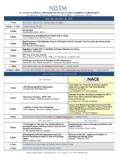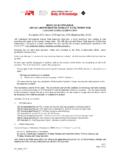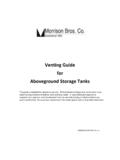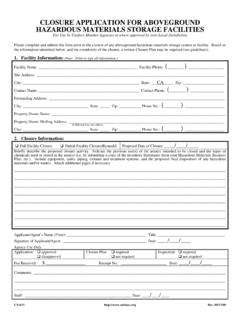Transcription of Fuel Storage - Connecticut
1 fuel StoragePotential Environmental Impacts: fuel spills are very damaging to the marina environment. According to the EPA,the complex hydrocarbon compounds in oil and gasoline are toxic to marine life,upset fish reproduction and interfere with growth and reproduction of bottomdwelling organisms. Legal Requirements: If your facility stores 10,000 pounds or more of gasoline, diesel fuel , and/orfuel oil, either above- or underground for dispensing or for on-site use, youmust report Storage of that substance under the Emergency Planning andCommunity Right-to-Know Act of 1986[42 11001, et seq.]. For specificreporting requirements, see Appendix A. Both aboveground and underground Storage tanks and their piping systemsare subject to the National Fire Protection Association s (NFPA) Automotiveand Marine Service Station Code(NFPA 30A).
2 These requirements areadopted locally. Check with your municipal fire marshal for localrequirements, or contact the State Fire Marshal s Office at 860-685-8380. Underground Petroleum Storage :Tanks with ten percent or more of totalvolume below grade (including the volume of connected underground pipes)are considered Underground Storage Tanks (USTs) and must meet certainrequirements, which were promulgated November 1, 1985 [RCSA 22a-449(d)-1and 22a-449(d)-101-113]. The general requirements are that:1) the tank and piping be constructed of noncorrosive materials orexternally coated cathodically protected steel and installed according tomanufacturer s specifications; 2) the facility has an approved method of leak detection which includesthe maintenance of all activity records for 5 years;3) fill-pipes on tanks have means to collect spills from delivery hoses; 4) the tanks have overfill protection, such as automatic shutoff deviceswhich activate at 90% UST capacity and restrict flow during deliveries;5) the tank be registered with the DEP and the local fire marshal (on theForm EPHM-6).
3 6) if a facility has a total underground buried Storage capacity of morethan 42,000 gallons of petroleum product, it may require a Spill,Prevention, Control, and Countermeasure (SPCC) Plan [40 CFR ].See Appendix E for more information. There are additional requirements for facility owners or operators when they areclosing USTs through removal or in-place abandonment [RCSA 22a-449(d)-107].Contact CT-DEP s Underground Storage Tank Program at 860-424-3374 for moreinformation or visit . aboveground Petroleum Storage :If your facility stores a certain amount ofgas or oil in aboveground tanks (a single tank with capacity greater than 660gallons, or more than one tank with total aboveground Storage capacity ofmore than 1,320 gallons) it may require an SPCC Plan [40 CFR ], which2007 Connecticut CLEAN MARINA GUIDEBOOK51 Connecticut DEPARTMENT OF ENVIRONMENTAL PROTECTION outlines a facility-wide plan to prevent spills and contingency plans in case ofspills.
4 The aboveground Storage tank should be located within a dike or overan impervious Storage area with containment volumes equal to 110% of thecapacity of the Storage tank. See Appendix E for more information. Gasoline Storage :All gasoline Storage tanks with a capacity of 250 gallons ormore are subject to the Stage I Regulations for reduction of the impacts ofgasoline vapors on air quality. Under Stage I Regulations, all Storage tankswith a capacity of 250 gallons (950 liter) or more which contain any volatileorganic compound with a vapor pressure of pounds per square inch orgreater under actual Storage conditions must have a permanent submergedfill pipe with a discharge point eighteen (18) inches or less from the bottomof the Storage vessel unless it is a pressure tank as described in RCSA 22a-174-20(a)(2) [RCSA 22a-174-20(a)(3)].
5 Tanks which are exempt from thisregulation are those that have a capacity of less than 1,000 gallons which wereinstalled prior to June 1, 1972, and underground tanks which were installedbefore June 1, 1972 and have an offset fill pipe. Stage II Vapor Recoveryrequirements do not apply to marine service stations. For more information,contact CT-DEP s Bureau of Air Management at (860)-424-3027. Any fuel spill to the waters of the state must be reported to the DEP Oil andChemical Spill Response Division at 860-424-3338[CGS 22a-450]. SeeAppendix E for state and federal spill reporting requirements. If the fuel that is discharged into navigable waters causes a visible sheen, itmay also be necessary to report a spill to the National Response Center at 1-800-424-8802 [Section 311 of the Clean Water Act; 33 1321].
6 See Appendix E forthe state and federal spill reporting requirements. A hazardous waste determination must be conducted on any materials used toclean a spill to determine whether or not disposal of the materials is subject tohazardous waste regulations [40 CFR ; RCSA 22a-449(c)-102(a)(2(A)]. Managehazardous waste as described in Appendix B. If there is a stormwater discharge from your facility, you may have to registerfor a General Permit for the Discharge of Stormwater Associated withIndustrial Activity( Stormwater General Permit ). See Appendix F for Management Practices: Keep all information about registered underground Storage tanks andsubsequent updates from CT-DEP and maintenance records filed in acentral location. Regularly inspect aboveground fuel Storage tanks and associated piping forleaks.)
7 If possible, cover the tank with a roof to prevent rainwater from filling thecontainment for Clean Marina Certification: Do you regularly inspect and repair fuel transfer and Storage equipment?YESNON/A52 Connecticut CLEAN MARINA GUIDEBOOK 2007 Connecticut DEPARTMENT OF ENVIRONMENTAL PROTECTION

















